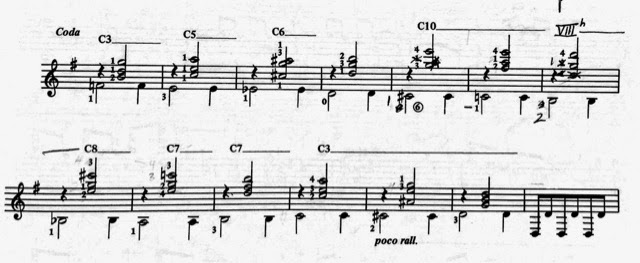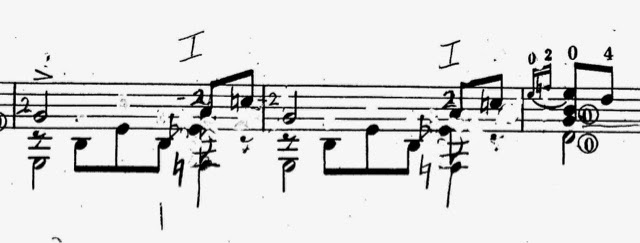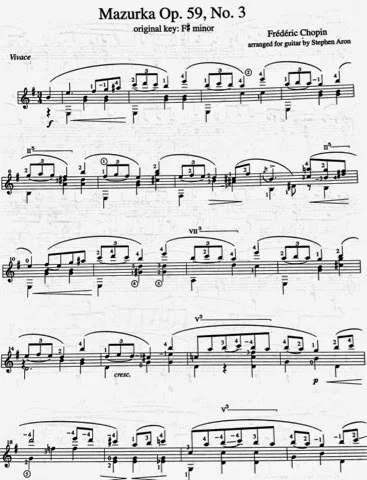Eliminate the Hard Parts: Editing the Score
It seems nearly every piece we play has a passage, a section, a moment- that is harder than the rest of it. These difficult spots tend to loom large in our psyches. As we approach them in performance, we sense them coming, and tense up as they near, guaranteeing it will be even harder to play them than it should be. They are often subjected to extra effort--multiples of repetitions to the accompaniment of the metronome, for instance, but they resist improvement and linger to tease us (or torture us) with their continuing difficulty.
In the music I play, and in my teaching, I strive to eliminate the hard parts.
As members of an audience, we are not aware of the fingering a performer uses, or why a certain interpretation was chosen, or what inner voice notes are being played. But we are acutely aware when a performer stumbles, hesitates or fumbles. One of the most elusive challenges in preparing music is to render the works we play more or less uniformly playable. That is, to eliminate the hard parts.
The question must arise: is the piece simply too hard for the player's current level of experience? Maybe so. What could be more common than a student trying a piece that is patently too difficult? And yet, as we grow and improve at our art, we inevitably encounter material that is genuinely too hard in a piece that is otherwise perfect for us. It is part of the process to push our playing up another level to introduce works with new challenges. So it is a universal concern. We look for the sweet spot in new repertoire: just enough new challenges to help us grow, but not so much that we feel overwhelmed or defeated. So we are inevitably confronted by these intransigent hard parts that just seem to elude us. How do we "eliminate" them?
There are four categories of activity that will help to achieve this goal: better practicing, improving fingering, working with the interpretation, and, as a last resort, editing the score.
Practicing
Of course, it's necessary to practice these sections intelligently. Analyze the material to understand why it is so difficult. Play it very, very slowly. Prepare carefully each movement of both hands. Isolate the hands and work with them independently to better understand and master their movements. Work on small units of material--a beat, a measure--at a time, and add on to that unit bit by bit. Apply alternate rhythms to help catapult a performance tempo up a few notches. If the material still resists, then consider changing the fingering.
Fingering
Most published editions have fingerings printed in them that need to be revised. I find it rare or possibly unknown to receive a score with fully usable fingerings. Partly this is because fingerings are personal, answering as they do to the needs of a particular person's hands--their strengths and weaknesses, their hand size. But it's also because many editors just plain miss opportunities to finger music in more elegant, easy-to-play, legato and generally more musical fashion. So it is important to evaluate fingerings when learning a piece for your own strengths and weaknesses, for your own hand size, for your interpretation. Especially in the hard parts. So, consider: in how many places on the instrument, and in how many configurations can the passage in question be played? It might be a simple matter of playing a note open that before you were fretting, or adding or removing a single slur. There are almost always alternate ways to finger. If you have truly exhausted options in fingering and the passage remains too difficult, then consider changing your interpretation.
Interpretation
While we benefit widely by practicing to the metronome, music is seldom played metronomically. There are countless examples in the literature in which a passage seems too difficult until a suitable phrasing is applied. A bit of rubato, a slight ritardando and a breath will give the music a chance to relax and pause, and, not incidentally, give the your hands a chance to find the notes. It is stylistically correct in nearly the entire repertoire to let the music breathe at cadences. Only in music that is defiantly rhythmical, or contemporary (in the sense of being disconnected from the lyrical and common-practice rhetoric that informs the majority of our works), is an absence of breathing likely to be the norm. Otherwise, take more time, and let the time you take better enable execution. Especially in the hard parts.
If, after practicing really well, revisiting the fingering, and exploring many possibilities for phrasing and pacing, you STILL can't manage to render the passage comfortable, then it is often possible to edit the score.
Editing
It is remarkable how much easier some passages become when a single note is removed. Thinning out a texture some, turning a series of four-note chords into a passage of four- and three-note chords, for instance, can often make it much more navigable.
The subject of editing is a touchy one. As a composer, I'm not too thrilled by the thought of someone "thinning out" my music. On the other hand, I'd be happy they were looking for ways to make it work for them. Inexperienced players--students--will often be unsure of what note might be considered more or less expendable and might make a bad decision, crippling a passage that might be salvaged more elegantly. When King Leopold told Mozart that his opera had "too many notes" (the movie, Amadeus), Mozart was dumbstruck: he responded "there are just as many notes, sire, as I require, neither more, nor less!" Well, yes, I get that. Still, it is ok to omit one or two, if it helps make a passage more playable. In the end, the audience will notice when the performer struggles, but no one would notice the kinds of small edits I sometimes apply when I play, or that I suggest from time to time to my students. I'll give a few examples of score edits, in an effort to illustrate what I mean.
In this excerpt of the Elegie by Mertz, the arpeggio passage has inspired numerous re-writes for the modern guitar. The problem is in the second measure below. Here it is as written:

And here is the edited version:

By simply replacing the B's with G#'s in those two beats, the critical bass line is saved, along with the characteristic f-e clash in the harmony. There is a new challenge, though: the re-written arpeggio features a repeated note and an odd spacing for the right hand. For me, this was manageable; others might make a different decision here.
This excerpt is from Barrios' Valse Op. 8, No. 4:

I found the left hand movements difficult at tempo and so chose to thin a couple of the chords:

In this passage from the second movement of Barrios' La Catedral, the "French Overture" style implied throughout necessitates an overdotting that is impossible here:

The passage sounds more consistent and stylistic and of course, is much easier, like this:

This cadential figure from Regondi's Reverie is perfectly playable as written but requires slowing down more than I want to (the last two chords of m1):

So a modest edit enables the interpretation I like to use:

On the first page of Rodrigo's Fandango, this passage confounds my left hand (beginning of m2):

A simple edit makes it comfortable:

I tried many times to perform the five-fret slur in this excerpt from Villa-Lobos' Schottish-Choro, but never felt fully in control of it, and the setup required more time than my interpretation wanted (beginning of m2):

This edit makes the passage a pleasure to play:

This chord sequence in Moreno-Torroba's Sonatina in A (first movement) is comfortable in the home key but here in E, the stretch is too large, making it a source of rhythmic delay at best, buzzing or missed notes at worst:

This re-voicing seems perfectly sensible:

Now it barely needs to be stated that players with really large hands (or small guitars) won't need that edit! Similarly, each of the suggestions made here have counter-arguments and alternate solutions. Some players will navigate the scores as written with no particular difficulty. Similarly, many of my students struggle with passages that don't trouble me. Also, different interpretations, different degrees of hand flexibility, different fingerings, will lead players to different conclusions. The point is that it is necessary, it is critical to seek solutions to your repertoire's most challenging passages. Remaining steadfast to the interpretation or fingering you stumbled across first, doesn't necessarily lead to great performance. We have to dig deeper sometimes, even to the point, on occasion, of removing notes, to find our way to a uniformly comfortable performance edition and interpretation. In keeping with the goal of avoiding fumbles, delays and other easily apparent difficulties on stage, we must eliminate the hard parts.





